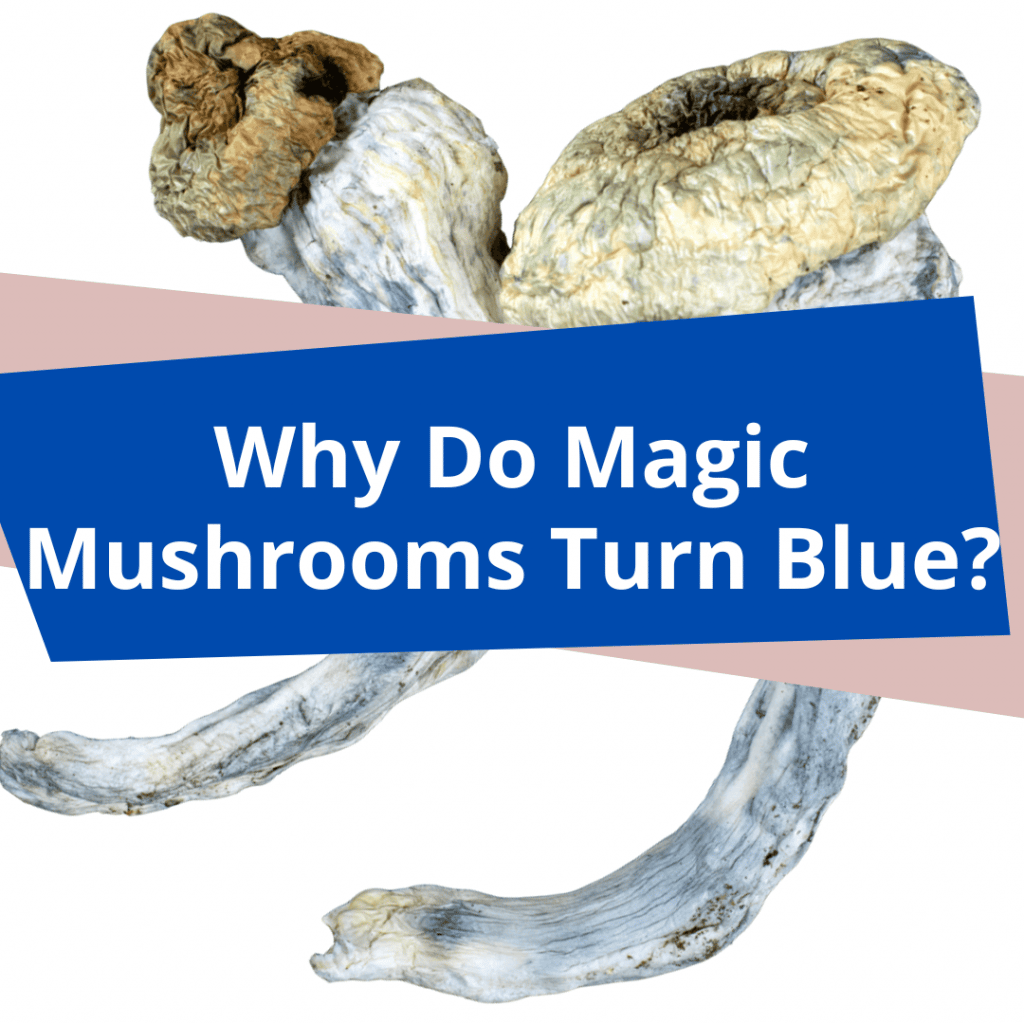Psychedelic magic mushrooms display a diverse array of distinguishing characteristics. And blue bruising is undeniably one of their unique charms. This identifying mark sends a message that the mushroom could be psychoactive. And yet, despite this near certainty among mycologists and scientists alike, the precise cause of the blue colouring was a chemical mystery until recently.
Oxidized Psilocin Turns Blue
All mushrooms can bruise from age, degradation, or careless harvesting. This process isn’t the same as bruising on human skin, which involves blood vessel damage. Instead, bruising initiates a series of chemical processes in mushrooms. Albert Hoffman conducted the first study of blue bruising in psilocybin mushrooms in 1967. And he confirmed that oxidated psilocin, bio-available psilocybin, was responsible for the blue colour. However, the precise chemical reaction for this blueing continued to evade researchers until 2019.
The oxidization of psilocin will not always produce noticeable blueing, although this doesn’t necessarily indicate lower concentrations of psilocybin. Psychonauts take note: more bruising often indicates reduced potency in psilocybin-containing mushrooms.
Psilocybin vs Psilocin: What’s Is the Difference?
Contrary to popular belief, psilocybin itself is technically not hallucinogenic. However, when our body processes it, it is converted to its bioactive form, psilocin, which is hallucinogenic. Magic mushrooms contain both psilocybin and psilocin. That being said, these compounds are not responsible for the blue colour in all mushrooms. There are edible mushroom varietals that turn blue due to other active compounds which are not psychoactive. Examples of these types of mushrooms include Edible Indigo Milk Cap and Boletes.
Blueing Reaction Enzymes Identified
When studying injury-triggered reactions in psilocybin mushrooms, Lenz and colleagues identified enzymes directly involved in the blueing reaction. Specifically, they discovered “a laccase and a phosphatase that degrade 1 and initiate blueing in P. cubensis… the blue color is due to a heterogeneous mixture of quinoid psilocyl oligomers, primarily coupled via C-5.” (Lenz et al., 2019)
Not All Psychadelic Mushrooms Turn Blue
While many notable varieties of psychoactive mushrooms turn blue, not all magic mushrooms do. Psilocybin and psilocin are not the primary psychoactive compounds present in all magic mushrooms. In the absence of psilocin or psilocybin, these psychedelic mushrooms have no reason to turn blue but instead exude other colours unique to their active compounds.
Inocybe Mushrooms
Many mycologists describe the Inocybe genus as typifying the LBM, Little Brown Mushroom (Kim, 2007). Many of them are poisonous and can cause organ failure. Some are psychedelic, and others innocuous, albeit edible. Although some Inocybe mushrooms do bruise blue in the stem, their colours typically range from beige and brown to pinks and some lilac or purple hues. Amanita muscaria is a well-known variety of psychoactive Inocybe.
Blue-Bruising Mushroom Types
We will take a quick look at three genera of blue-bruising mushrooms, the Panaeolus Genus, the Gymnopilus Genus, and the notorious Psilocybe Genus.
Psilocybe Genus
The Psilocybe genus bruises blue. It contains Psilocybe cubensis, a well-known variety of psychedelic mushrooms. Like Inocybe mushrooms, the psilocybe genus is also regarded by the mycology community as an LBM. So famous are the blue bruises on Psilocybe mushrooms that budding mycologists and psychonauts find them easy to identify. Golden Teacher Cubensis is a popular, world-renowned member of the Psilocybe genus.
Psilocybe mushrooms are gaining traction and popular acceptance as a non-addictive, highly effective pharmacological and psychotherapeutic medicine. Studies prove that following single, high-dose administrations, the overwhelmingly positive effects can last for many months. Furthermore, the experiences provided by these high doses are cumulative, making for meaningfully low rates of remission. Both microdoses and full doses of psychedelic magic mushrooms have been and are being tested in a variety of psychotherapeutic studies. Both styles are proving effective in various applications in everything from anxiety to anorexia.
Panaeolus Genus
The Panaeolus genus of mushrooms is characterized by its spotted gills. Like the Psilocybe mushrooms, Panaeolus aren’t prized as edible culinary mushrooms. There are thirteen psilocin and psilocybin-containing species that mycologists sometimes group as Copelandia, a unique genus. Researchers posit that in addition to serotonin, this genus contains many unidentified psychoactive compounds. A typical variety of these blue-bruising mushrooms is Panaeolus cinctulus.
Gymnopilus Genus
Like the Panaeolus Genus of mushrooms, Gymnopilus is a gilled genus with a handful of psychoactive species. Characterized by yellow, burnt-orange to reddish brown fruiting bodies, there are fourteen members of Gymnopilus that contain psilocybin, bruise blue, and have a prohibitively bitter taste. An aptly named member is Gymnopilus Cyanopalmicola.
References
Gilmour, L. P., and O’Brien, R. D. (1967) “Psilocybin: Reaction with a Fraction of Rat Brain,” Science, [online] Available from: https://www.science.org/doi/10.1126/science.155.3759.207 (Accessed 9 August 2022).
Lenz, C., Wick, Dr., J. and Braga, Dr., D. (2019) “Injury-Triggered Blueing Reactions of Psilocybe’ Magic’ Mushrooms,” Wiley Online Library, [online] Available from: https://onlinelibrary.wiley.com/doi/10.1002/anie.201910175 (Accessed 10 August 2022).
